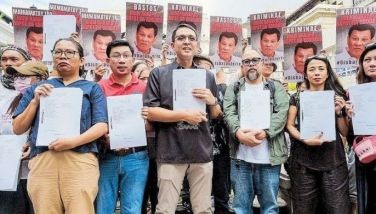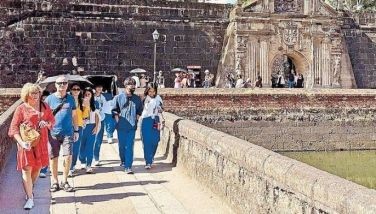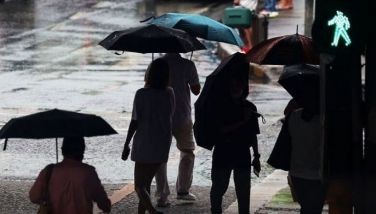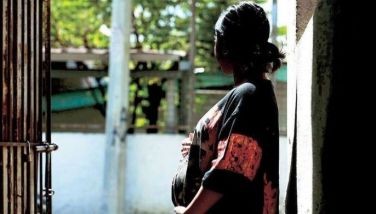Yearender: RP’s war on terror: Abu Sayyaf loses chief, spokesman in clashes
The country’s campaign against Islamic extremists, who are believed to have ties with Osama bin Laden’s al-Qaeda terror network, was highlighted in the international arena with two significant events at the start of 2007.
Last Jan. 20, Philippine military and police authorities, with the aid of the US Federal Bureau of Investigation, confirmed through DNA testing the death of Abu Sayyaf bandit group chieftain Khadaffy Janjalani.
Janjalani carried a $5-million bounty on his head.
The notorious bandit group leader was said to have been killed in a clash with the elite Marine Force Recon in Barangay Tugas, Patikul, Sulu on
His cadaver was discovered by soldiers in the same village on Dec. 27 last year, after four Abu Sayyaf members who surrendered to government forces pinpointed the location of a shallow grave where Janjalani’s remains were said to have been buried following the September firefight, which also left six Marines dead.
With his death, Armed Forces chief Gen. Hermogenes Esperon Jr. said the military has “neutralized the center of gravity of terrorism” in the Philippines.
With Janjalani’s death, the Philippine government earned praises, particularly from the
Four days prior to the confirmation of Janjalani’s death, government forces reportedly killed Abu Sayyaf strategist and spokesman Jainal Antel Sali, alias Abu Solaiman, in the hinterlands of Talipao town, also in Sulu, by elite Army Special Forces who daringly stalked and sneaked into the bandits’ jungle lair.
Janjalani and Solaiman, together with several Abu Sayyaf lieutenants, had been charged after being held responsible for several deadly attacks, including the bombing of SuperFerry 14 off
Solaiman is also tagged as the “master planner” in the abduction of 17 Filipinos and three American tourists – missionary couple Martin and Gracia Burnham and Guillermo Sobero – from a resort in
The bandits beheaded Sobero while Martin was killed during a military rescue in June 2002, which also wounded his wife, Gracia.
Last Aug. 1, the military launched Oplan Ultimatum 2, which involved the deployment of some 4,000 government forces in the island province of Sulu, in a bid to flush out the remaining leaders of the Abu Sayyaf — Radullan Sahiron, Isnilon Hapilon and Abu Pula, and their followers.
The death of the two key Abu Sayyaf figures was considered by the military as “significant victories” in its campaign against terrorism.
Last month, Esperon announced that he has given forces in Sulu, particularly soldiers under the operational control of Joint Task Force Comet, two months to finally put an end to the notorious kidnap-for-ransom group.
But in a recent news forum, the military top brass admitted that crushing the notorious bandit group could take a little longer than the two-month timeframe.
With the implementation of Oplan Bantay Laya 2 last January, the government’s internal security operations master plan, the military leadership hopes to finally wipe out the bandit group, along with other threats to national security such as the communist rebellion in the countryside.
Steep price to pay
The country was shocked upon hearing news that 10 out of the 15 Marines killed in a clash with Moro Islamic Liberation Front (MILF) rebels in Albarkah town in Basilan last July 10 were beheaded and mutilated.
Party lines were crossed, as even militant groups scored the “inhumane” act that was supposed to have been covered by the bounds of international agreements on the conventions of war.
Although the MILF leadership denied having perpetrated the beheading, it blamed the military for “entering their territory without coordination” with the rebel group. But the Marines claimed they responded to information that Fr. Giancarlo Bossi, the Italian parish priest of Zamboanga Sibugay who was reportedly snatched by Abu Sayyaf gunmen, was taken to Basilan.
Following the clash, combined military and police elements scoured the area, armed with warrants of arrest, to search for the perpetrators.
But up to now, justice has yet to be served on behalf of the fallen Marines, who were forced to go into battle even if their objective was to help in the search for Bossi.
The high casualty count for the Marines was repeated following an assault at a suspected camp of the Abu Sayyaf in Ungkaya Pukan town, also in Basilan.
Fifteen Marines, including five young lieutenants, were killed in the fierce encounter.
The leadership of the Philippine Marine Corps, one of the elite units of the Armed Forces, ordered an investigation to determine what could have contributed to the heavy death toll. Several officers have also been relieved from their posts after the two major clashes.
Late this year, the government and the MILF, the largest Muslim secessionist group in
Both panels have expressed optimism that peace, which eluded the people of conflict-torn areas of
But even before a final peace agreement could be reached, pockets of violence still erupted from time to time, making the peace and order situation in these areas even more volatile.
Peace remains elusive in this Promised Land, and both government and rebel panels must work even harder in the year ahead to bring a final and lasting solution to this tragic cycle of violence.
- Latest
- Trending































